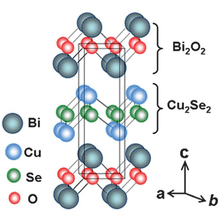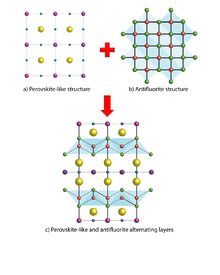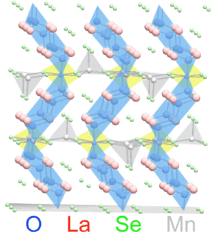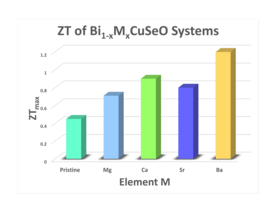Oxyselenide
Oxyselenides are a group of chemical compounds that contain oxygen and selenium atoms (Figure 1). Oxyselenides can form a wide range of structures in compounds containing various transition metals, and thus can exhibit a wide range of properties. Most importantly, oxyselenides have a wide range of thermal conductivity, which can be controlled with changes in temperature in order to adjust their thermoelectric performance. Current research on oxyselenides indicates their potential for significant application in electronic materials.[1]

Synthesis
The first oxyselenide to be crystallized was manganese oxyselenide in 1900.[2] In 1910, oxyselenides containing phosphate were created by treating P2Se5 with metal hydroxides.[3] Uranium oxyselenide was formed next by treating H2Se with uranium dioxides at 1000 °C.[4] This technique was also utilized in synthesizing oxyselenides of rare-earth elements in the mid-1900s.[5] Synthesis of oxyselenide compounds currently involves treating oxides with aluminum powder and selenium at high temperatures.[6]

Recent discoveries in iron oxyarsenides and their superconductivity have highlighted the importance of mixed anion systems.[7] Mixed copper oxychalcogenides came about when the electronic properties of both chalcogenides and oxides were taken into account. Chemists began pursuing the synthesis of a compound with metallic and charge density wave properties as well as high temperature superconductivity. Upon synthesizing the copper oxyselenide Na1.9Cu2Se2·Cu2O by reacting Na2Se3.6 with Cu2O,[8] they concluded that a new type of oxychalcogenides could be synthesized by reacting metal oxides with polychalcogenide fluxes.
Derivatives

New oxyselenides of the formula Sr2AO2M2Se2 (A=Co, Mn; M=Cu, Ag) have been synthesized. They crystallize into structures consisting of alternating perovskite-like (metal oxide) and antifluorite (metal selenide) layers (Figure 2). The optical band gap of each oxyselenide is very narrow, indicating semiconductivity.[9]
Another derivative that reveals oxyselenide properties is β-La2O2MSe2 (M= Fe, Mn). This molecule possesses an orthorhombic structure (Figure 3), opening up the possibilities for different packing arrangements of oxyselenides. They are ferromagnetic at low temperatures (~27 K) and show high resistivity at room temperature. The Mn analogue, diluted in NaCl solution, suggests an optical band gap of 1.6 eV at room temperature, making it an insulator. Meanwhile, the band gap for the Fe analogue is approximately 0.7 eV between 150 K and 300 K, making it a semiconductor.[7] In contrast, cobalt oxyselenide La2Co2O3Se2 is antiferromagnetically ordered, suggesting that although the different transition metals are responsible for the changes in an oxyselenide's magnetic property, the molecule's overall lattice structure may also influence its conductivity.[10]

The magnetic and conducting properties of different metal compounds coordinated with oxyselenide are not only affected by the transition metal used, but also by the synthesis conditions. For example, the percentage of aluminium used during the synthesis of Ce2O2ZnSe2 as an oxygen retriever affected the band gaps, indicated by the varying product colours.[6] Various structures allow for many potential configurations. For example, as observed before in La2Co2O3Se2, Sr2F2Mn2Se2O exhibits a frustrated magnetic correlation in the structure resulting in an antiferromagnetic lattice.[11]
In 2010, p-type polycrystalline BiCuSeO oxyselenides were reported as possible thermoelectric materials.[12] The weak bonds between the [Cu2Se2]−2 conducting and [Bi2O2]+2 insulating layer, as well as the anharmonic crystal lattice structure, may account for the substance's low thermal conductivity and high thermoelectric performance. Recently, BiCuSeO's ZT value, a dimensionless figure-of-merit indicating thermoelectric performance, has been increased from 0.5 to 1.4. Experiment has shown that Ca doping can improve electrical conductivity, thereby increasing the ZT value.[1] Additionally, replacing 15% of the Bi3+ ions with group 2 metal ions, Ca2+, Sr2+, or Ba2+ (Figure 4), also optimizes the charge carrier concentration.[12]
References
- Pei, Yan-Ling; He, Jiaqing; Li, Jing-Feng; Li, Fu; Liu, Qijun; Pan, Wei; Barreteau, Celine; Berardan, David; Dragoe, Nita; Zhao, Li-Dong (2013). "High thermoelectric performance of oxyselenides: intrinsically low thermal conductivity of Ca-doped BiCuSeO". NPG Asia Materials. 5 (5): e47. doi:10.1038/am.2013.15. ISSN 1884-4057.
- Fonzes-Diacon, H. (1990). "A synthesized selenide and an oxyselenide of manganese". Competes Rendus Hebdomadaires des Séances de l'Académie des Sciences 130: 1025: 1025–6.
- Ephraim, F., and E. Majler. (1910). "Selenophosphates". Berichte der Deutschen Chemischen Gesellschaft 43: 277–285.
- Khodadad, P. (1957) "Uranium Oxyselenide. UOSe". Compt. Rend. 245: 226: 2286–8.
- Guittard, M., Flahaut, J., and Domange, L. "The oxyselenide of Yttrium and all the rare earths". Acta Crystallographica 21 (5).
- Ainsworth, Chris M.; Wang, Chun-Hai; Tucker, Matthew G.; Evans, John S. O. (2015). "Synthesis, Structural Characterization, and Physical Properties of the New Transition Metal Oxyselenide Ce2O2ZnSe2" (PDF). Inorganic Chemistry. 54 (4): 1563–1571. doi:10.1021/ic502551n. ISSN 0020-1669. PMID 25584771.
- McCabe, Emma E.; Free, David G.; Mendis, Budhika G.; Higgins, Joshua S.; Evans, John S. O. (2010). "Preparation, Characterization, and Structural Phase Transitions in a New Family of Semiconducting Transition Metal Oxychalcogenides β-La2O2MSe2 (M = Mn, Fe)". Chemistry of Materials. 22 (22): 6171–6182. doi:10.1021/cm1023103. ISSN 0897-4756.
- Park, Younbong; DeGroot, Don C.; Schindler, Jon L.; Kannewurf, Carl R.; Kanatzidis, Mercouri G. (1993). "Intergrowth of two different layered networks in the metallic copper oxyselenide Na1.9Cu2Se2⋅Cu2O". Chemistry of Materials. 5 (1): 8–10. doi:10.1021/cm00025a004. ISSN 0897-4756.
- Jin, Shifeng; Chen, Xiaolong; Guo, Jiangang; Lei, Ming; Lin, Jingjing; Xi, Jianguo; Wang, Wenjun; Wang, Wanyan (2012). "Sr2Mn3Sb2O2Type Oxyselenides: Structures, Magnetism, and Electronic Properties of Sr2AO2M2Se2(A=Co, Mn;M=Cu, Ag)". Inorganic Chemistry. 51 (19): 10185–10192. doi:10.1021/ic301022g. ISSN 0020-1669.
- Fuwa, Yayoi; Endo, Takashi; Wakeshima, Makoto; Hinatsu, Yukio; Ohoyama, Kenji (2010). "Orthogonal Spin Arrangement in Quasi-Two-Dimensional La2Co2O3Se2". Journal of the American Chemical Society. 132 (51): 18020–18022. doi:10.1021/ja109007g. ISSN 0002-7863.
- Liu, Y.; Zhang, S.B.; Li, L.J.; Lu, W.J.; Zhao, B.C.; Tong, P.; Song, W.H.; Lin, S.; Huang, Y.N.; Huang, Z.H.; Tan, S.G.; Sun, Y.P. (2013). "Synthesis, structure and properties of the new layered manganese oxyselenide Sr2F2Mn2Se2O". Journal of Alloys and Compounds. 580: 211–216. doi:10.1016/j.jallcom.2013.05.048. ISSN 0925-8388.
- Zhao, Li-Dong; He, Jiaqing; Berardan, David; et al. (2014). "BiCuSeO oxyselenides: new promising thermoelectric materials". Energy & Environmental Science. 7 (9): 2900. doi:10.1039/C4EE00997E. ISSN 1754-5692.